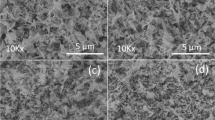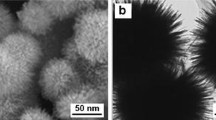Abstract
The novel hierarchical sea-urchin-like Fe3O4/SnO2 heterostructures with SnO2 nanorod arrays grown on Fe3O4 nanoparticles were fabricated via a SnO2-seeded heteroepitaxial growth of SnO2 nanorod arrays on Fe3O4 nanoparticles. Moreover, the Fe3O4/SnO2 heterostructures showed notable photocatalytic degradation compared with the pure SnO2 in aqueous solution. The degradation reached 89% in 5 h. The remarkable improvement in photocatalytic efficiency was ascribed to larger specific surface area introducing more active sites. In addition, the decline in degradation efficiency of p-chlorophenol is not more than 11.4% after recycling for seven times in accordance with practice which indicates the excellent repeated availability. The enhanced photocatalytic performance and features that can be easily recovered and separated make Fe3O4/SnO2 have great potential application in the environmental remediation.










Similar content being viewed by others
References
Chen R, Wang W, Zhao X, Zhang Y, Wu S, Li F (2014) Rapid hydrothermal synthesis of magnetic CoxNi1−xFe2O4 nanoparticles and their application on removal of Congo red. Chem Eng J 242:226–233
Wu W, Jiang CZ, Roy VA (2015) Recent progress in magnetic iron oxide–semiconductor composite nanomaterials as promising photocatalysts. Nanoscale 7:38–58
You J, Xiang Y, Ge Y, He Y, Song G (2017) Synthesis of ternary rGO–ZnO–Fe3O4 nanocomposites and their application for visible light photocatalytic degradation of dyes. Clean Techn Environ Policy 19:2161–2169
Zheng L, Pi F, Wang Y, Xu H, Zhang Y, Sun X (2016) Photocatalytic degradation of acephate, omethoate, and methyl parathion by Fe3O4@SiO2@mTiO2 nanomicrospheres. J Hazard Mater 315:11–22
Chen Z, Wang J, Pu Z, Zhao Y, Jia D, Chen H, Wen T, Hu B, Alsaedi A, Hayat T, Wang T (2017) Synthesis of magnetic Fe3O4/CFA composites for the efficient removal of U(VI) from wastewater. Chem Eng J 320:448–457
Gao S, Guo C, Hou S, Wan L, Wang Q, Lv J, Zhang Y, Gao J, Meng W, Xu J (2017) Photocatalytic removal of tetrabromobisphenol A by magnetically separable flower-like BiOBr/BiOI/Fe3O4 hybrid nanocomposites under visible-light irradiation. J Hazard Mater 331:1–12
Wang Y, Ning J, Hu E, Zheng C, Zhong Y, Hu Y (2015) Direct coating ZnO nanocrystals onto 1D Fe3O4/C composite microrods as highly efficient and reusable photocatalysts for water treatment. J Alloys Compd 637:301–307
Sargolzaei J, Moghaddam AH, Nouri A, Shayegan J (2014) Modeling the removal of phenol dyes using a photocatalytic reactor with SnO2/Fe3O4 nanoparticles by intelligent system. J Dispers Sci Technol 36:540–548
Huang J, Xu X, Gu C, Yao S, Sun Y, Liu J (2012) Large-scale selective preparation of porous SnO2 3D architectures and their gas-sensing property. CrystEngComm 14:3283–3290
Chai X, Shi C, Liu E, Li J, Zhao N, He C (2016) Hierarchically structured carbon-coated SnO2–Fe3O4 microparticles with enhanced lithium storage performance. Appl Surf Sci 361:1–10
Wang L, Huang Y, Ding X, Liu P, Zong M, Sun X, Wang Y, Zhao Y (2013) Supraparamagnetic quaternary nanocomposites of graphene@Fe3O4@SiO2@SnO2: synthesis and enhanced electromagnetic absorption properties. Mater Lett 109:146–150
Jin C, Wang Y, Tang H, Wei H, Liu X, Wang J (2014) Synthesis, characterization, and catalytic applications of core–shell magnetic carbonaceous nanocomposites. J Phys Chem C 118:25110–25117
Li J, Wei Y, Li W, Deng Y, Zhao D (2012) Magnetic spherical cores partly coated with periodic mesoporous organosilica single crystals. Nanoscale 4:1647–1651
Shal AA, Jafari A (2014) Study of structural and magnetic properties of superparamagnetic Fe3O4–ZnO core–shell nanoparticles. J Supercond Nov Magn 27:1531–1538
Liu J, Cheng J, Che R, Xu J, Liu M, Liu Z (2012) Double-shelled yolk–shell microspheres with Fe3O4 cores and SnO2 double shells as high-performance microwave absorbers. J Phys Chem C 117:489–495
Khashan S, Dagher S, Tit N, Alazzam A, Obaidat I (2017) Novel method for synthesis of Fe3O4@TiO2 core/shell nanoparticles. Surf Coat Technol 322:92–98
Li W, Wu H (2017) Sodium citrate functionalized reusable Fe3O4@TiO2 photocatalyst for water purification. Chem Phys Lett 686:178–182
Lee HU, Lee SC, Lee YC, Vrtnik S, Kim C, Lee S, Lee YB, Nam B, Lee JW, Park SY, Lee SM, Lee J (2013) Sea-urchin-like iron oxide nanostructures for water treatment. J Hazard Mater 262:130–136
Housaindokht MR, Zamand N (2015) A DFT study of associative and dissociative chemical adsorption of DMMP onto SnO2 (110) surface nano-cluster. Struct Chem 26:87–96
Leostean C, Pana O, Stefan M, Popa A, Toloman D, Senila M, Gutoiu S, Macavei S (2018) New properties of Fe3O4@SnO2 core shell nanoparticles following interface charge/spin transfer. Appl Surf Sci 427:192–201
Dam B, Patil RA, Ma YR, Pal AK (2017) Preparation, characterization and catalytic application of nano-Fe3O4–DOPA–SnO2 having high TON and TOF for non-toxic and sustainable synthesis of dihydroquinazolinone derivatives. New J Chem 41:6553–6563
Jo YH, Do SH, Kong SH (2014) Persulfate activation by iron oxide-immobilized MnO2 composite: identification of iron oxide and the optimum pH for degradations. Chemosphere 95:550–555
Jia Z, Liu J, Wang Q, Li S, Qi Q, Zhu R (2015) Synthesis of 3D hierarchical porous iron oxides for adsorption of Congo red from dye wastewater. J Alloys Compd 622:587–595
Taherian S, Entezari MH, Ghows N (2013) Sono-catalytic degradation and fast mineralization of p-chlorophenol: La(0.7)Sr(0.3)MnO3 as a nano-magnetic green catalyst. Ultrason Sonochem 20:1419–1427
Alimoradzadeh R, Assadi A, Nasseri S, Mehrasbi MR (2012) Photocatalytic degradation of 4-chlorophenol by UV/H2O2/NiO process in aqueous solution. Iran J Environ Health 9(12):1–8
Bian W, Song X, Liu D, Zhang J, Chen X (2011) The intermediate products in the degradation of 4-chlorophenol by pulsed high voltage discharge in water. J Hazard Mater 192:1330–1339
He Z, Xie L, Song S, Wang C, Tu J, Hong F, Liu Q, Chen J, Xu X (2010) The impact of silver modification on the catalytic activity of iodine-doped titania for p-chlorophenol degradation under visible-light irradiation. J Mol Catal A 319:78–84
Huang Z, Wu P, Gong B, Zhang X, Liao Z, Chiang PC, Hu X, Cui L (2017) Immobilization of visible light-sensitive (N, Cu) co-doped TiO2 onto rectorite for photocatalytic degradation of p-chlorophenol in aqueous solution. Appl Clay Sci 142:128–135
Kim JK, Martinez F, Metcalfe IS (2007) The beneficial role of use of ultrasound in heterogeneous Fenton-like system over supported copper catalysts for degradation of p-chlorophenol. Catal Today 124:224–231
Singh S, Garg A (2017) Catalytic oxidative degradation of 4-chlorophenol: effect of operating parameters and prediction of intermediates/by-products. Environ Prog Sustain Energy 36:1734–1742
Song S, Hong F, He Z, Cai Q, Chen J (2012) AgIO3-modified AgI/TiO2 composites for photocatalytic degradation of p-chlorophenol under visible light irradiation. J Colloid Interface Sci 378:159–166
Su J, Lin S, Chen Z, Megharaj M, Naidu R (2011) Dechlorination of p-chlorophenol from aqueous solution using bentonite supported Fe/Pd nanoparticles: synthesis, characterization and kinetics. Desalination 280:167–173
Yan X, Zhu T, Fan X, Sun Y (2014) Removal of p-chlorophenol in mist by DC corona discharge plasma. Chem Eng J 245:41–46
Zhang WH, Quan X, Zhang ZY (2007) Catalytic reductive dechlorination of p-chlorophenol in water using Ni/Fe nanoscale particles. J Environ Sci 19:362–366
Zhao G, Lv B, Jin Y, Li D (2010) P-chlorophenol wastewater treatment by microwave-enhanced catalytic wet peroxide oxidation. Water Environ Res 82:120–127
Liu YL, Wu QS, Zhao YP (2017) Biomimetic synthesis of Ag3PO4-NPs/Cu-NWs with visible-light-enhanced photocatalytic activity for degradation of the antibiotic ciprofloxacin. Dalton Trans 46:6425–6432
Gupta A, Garg A (2018) Degradation of ciprofloxacin using Fenton’s oxidation: effect of operating parameters, identification of oxidized by-products and toxicity assessment. Chemosphere 193:1181–1188
Biglarijoo N, Mirbagheri SA, Ehteshami M (2016) Optimization of Fenton process using response surface methodology and analytic hierarchy process for landfill leachate treatment. Process Saf Environ Prot 104:150–160
Funding
This study was funded by the State Key Laboratory of Pollution Control and Resource Reuse Foundation (No. PCRRF17029), the National Natural Science Foundation of China (No. 21471114) and the State Major Research Plan (973) of China (No. 2011CB932404).
Author information
Authors and Affiliations
Corresponding authors
Ethics declarations
Conflict of interest
The authors declared that they have no conflicts of interest to this work. We declare that we have no financial and personal relationships with other people or organizations that can inappropriately influence our work, and there is no professional or other personal interest of any nature or kind in any product, service and/or company that could be construed as influencing the position presented in, or the review of, the manuscript entitled.
Electronic supplementary material
Below is the link to the electronic supplementary material.
Rights and permissions
About this article
Cite this article
Li, J., Chen, Y., Wu, Q. et al. Synthesis of sea-urchin-like Fe3O4/SnO2 heterostructures and its application for environmental remediation by removal of p-chlorophenol. J Mater Sci 54, 1341–1350 (2019). https://doi.org/10.1007/s10853-018-2899-7
Received:
Accepted:
Published:
Issue Date:
DOI: https://doi.org/10.1007/s10853-018-2899-7




